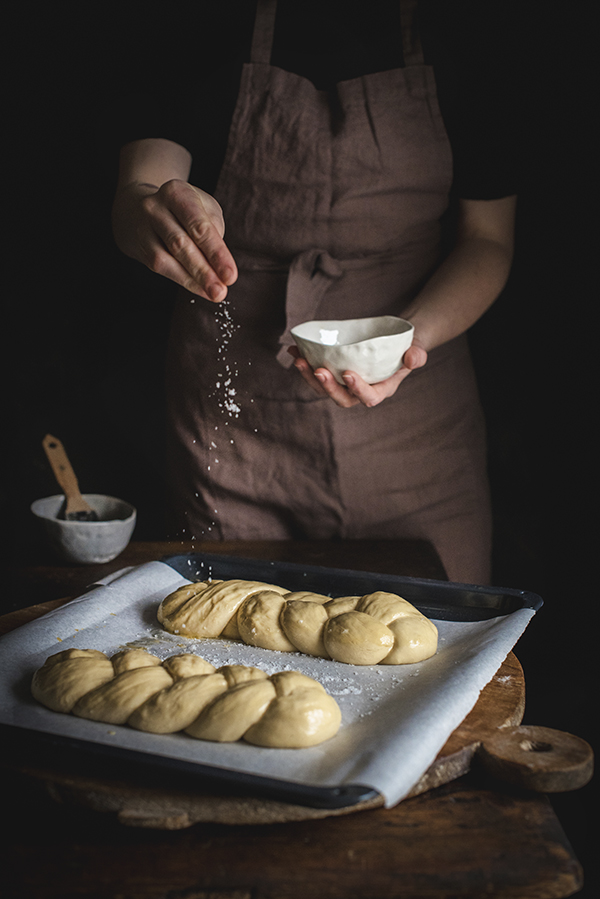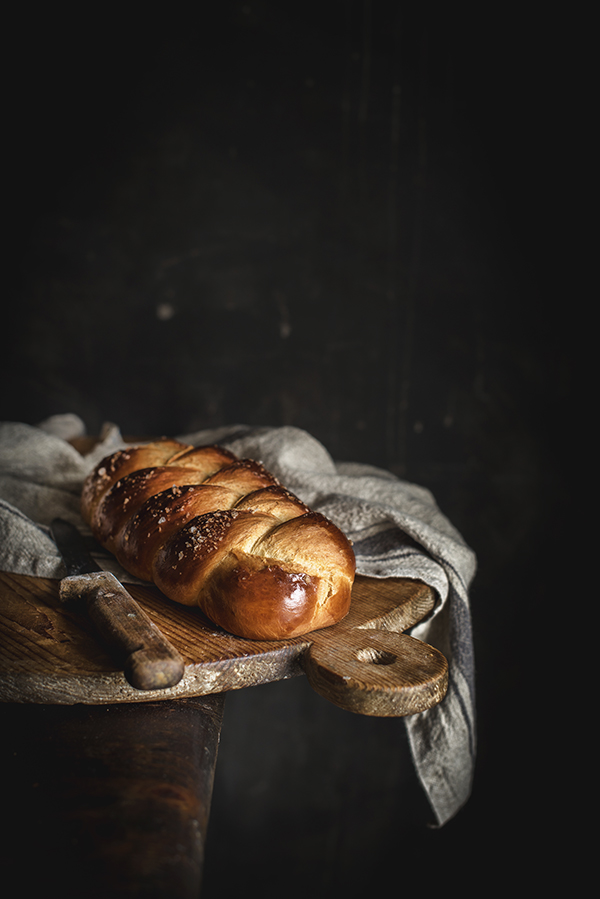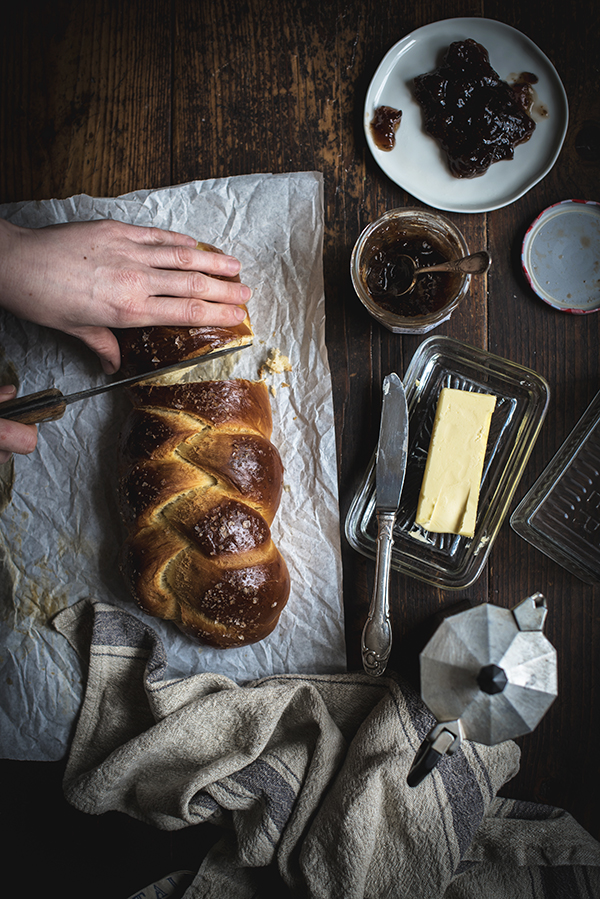Sveiki,
Šį kartą dalinuosi tradiciniu chalos receptu (o chalos variacijų yra begalės, nuo tradicinės su aguonomis ar sezamo sėklomis iki chalos su šokoladu ar pistacijomis). Tradicinė žydiška chala man visada asocijuojasi su šventėmis. Dažniausiai Vėlykomis. Kai tik pagalvoju apie chalą, man iškart mintyse iškyla vaizdas kaip aš valgau Velykų pusryčius. Atsiriekiu riekę šviežios pynutės ir užsitepu ją gausiai sviestu. Ar gali būti kas nors skaniau? Taip, taip, sakysite jūs, gali. Ir būsite teisūs. Bet aš, būdama paprastų dalykų mylėtoja, manau, kad šviežia duona su geru sviestu yra vienas skaniausių patiekalų.
Chalą pagaminti nereikia turėti didelių įgūdžių. Tiesiog reikia nuosekliai laikytis instukcijos, turėti pakankamai kantrybės minkant tešlą ir atsispirti pagundai pridėti daugiau miltų, nes pradžioje tešla būna tikrai lipni. Aš, turiu prisipažinti, labai nemėgstu dirbti su mieline tešla. Visų pirma, dėl mielių kvapo. Negaliu jo pakęsti. Man pradeda skaudėti galvą, po to pradeda pykinti ir visas tešlos minkymo procesas pradeda virsti labai nemaloniu reikalu. Todėl, kad ir kokį nepakartojamą terapinį poveikį turi tešlos minkymas, aš renkuosi virtuvinį kombainą, kuris tešlą puikiai išminko už mane, o aš išvengiu nemalonaus galvos skausmo.
Šios chalos su druska receptą rasite žemiau. Iki kitų gardžių kartų!
Hi there,
I want to share a traditional challah bread recipe this time. This traditional jewish braided bread always associated to me with holidays. Especially with Easter holidays. If I think about challah bread I immediately imagine my Easter breakfast. How I slice fresh homemade braided bread and spread a thick layer of butter on it. What could be more delicious? As a lover of good simple things I think that fresh bread and good quality butter is one of the most delicious things ever.
To make a challah you don’t need to be a professional baker. Everyone can make it at home. Just follow recipe directions, have enough patience to knead the dough and resist the temptation to add more flour, because the dough is really sticky at the beginning. To be honest, I don’t like to make yeast dough. It’s because I hate the smell of yeast. It makes me feel sick and affects worst headache. Then the dough kneading process turns into a very unpleasant affair. So despite of the unique therapeutic effect of the dough kneading by hand I choose stand mixer and dough hook attachment. It makes really good dough and I can avoid an unpleasant headache.
Find the recipe below and till the next delicious time!
Chala su jūros druska
250 ml šilto vandens (apie 36℃)
7 g sausų mielių (arba 20 g šviežių mielių)
65 g cukraus
60 ml aliejaus (saulėgrąžų, rapsų ar alyvuogių)
3 kiaušinių
2 a. š. smulkios jūros druskos
550 g miltų
2 v. š. jūros druskos dribsnių chalai apibarstyti
Į didelį dubenį sudėkite mieles, vieną šaukštą cukraus, supilkite šiltą vandenį ir išmaišykite. Palikite pastovėti apie 10 min., kol masė pradės putoti.
Į mielių masę suberkite smulkią jūros druską, likusį cukrų, sudėkite du kiaušinius, supilkite aliejų ir viską išmaišykite. Toliau, maišydami rankomis ar elektriniu plaktuvu su specialiu antgaliu mielinei tešlai minkyti, dalimis sudėkite persijotus miltus. Maišykite tol, kol tešla taps vientisa ir elastinga.
Kai tešlą išminkysite, suformuokite kamuolį ir dėkite jį į šiek tiek aliejumi išteptą dubenį. Uždenkite dubenį aliejumi ištepta maistine plėvele ir dėkite į šaldytuvą 10 - 12 val. Geriausia tešlą ruošti vakare, tuomet palikite ją šaldytuve per naktį, o ryte gaminkite toliau.
Po 10 - 12 val. išimkite tešlą iš šaldytuvo ir palikite kambario temperatūroje apie 45 - 60 min. Tuomet dubenį su tešla pastatykite šiltesnėje vietoje ir palikite apie 1,5 val. kol tešlos kiekis padvigubės.
Kai tešla pakils “nusodinkite” ją minkydami. Vėl suformuokite kamuolį ir dėkite į šiek tiek aliejumi išteptą dubenį, uždenkite aliejumi patepta maistine plėvele ir palikite šiltesnėje vietoje, kol tešla pakils dvigubai.
Iškilusią tešlą vėl “nusodiknkite” minkydami ją rankomis. Padalinkite į tris lygias (turėsite vieną didelę pynutę) arba šešias lygias dalis (turėsite dvi mažesnes pynutes). Iš kiekvienos dalies suformuokite pailgas apie 20 cm (jei dalinote į šešias dalis) ar 40 cm (jei dalinote į tris dalis) ilgio tešlos dešras. Iš trijų dešrų supinkite pynes. Pynių kraštus užlenkite ir gerai prispauskite po pačia pyne. Perkelkite pynes ant kepimo popieriumi išklotos kepimo skardos.
Išplakite vieną kiaušinį su vienu arbatiniu šaukšteliu vandens ir šiuo plakiniu aptepkite pynutes. Uždenkite pynutes maistine plėvele ir palikite dar apie 45 - 60 min., kad pakiltų dvigubai.
Įkaitinkite orkaitę iki 180℃. Iškilusius pynutes dar kartą aptepkite kiaušinio plakiniu ir apibarstykite jūros druskos dribsniais. Kepkite įkaitintoje orkaitėje apie 35 - 40 min., kol pynučių pluta taps tamsiai rudos spalvos. Iškepusias pynutes išimkite iš orkaitės ir perkelkite jas ant grotelių, kad atvėstų.
Skanaus!
Sea Salt Challah Bread
250 ml warm water (about 36℃)
7 g dried yeast (or 20 g fresh yeast)
65 g sugar
60 ml oil (sunflower, rapeseed or olive oil)
3 eggs
2 tsp fine sea salt
550 g flour
2 tbsp sea salt flakes to sprinkle the challah
Into a large bowl place the yest, pour warm water, add one tablespoon sugar, mix lightly and leave for about 10 minutes until foamy.
Into the bowl with yeast place the rest of the sugar, fine sea salt, two eggs, pour oil and stir until evenly mixed. Mix in flour in three bathes. You can mix it by hand or using stand mixer with dough hook attachment. Mix the dough until silky and stretchy.
Shape the dough into a ball. Oil a large bowl and place the dough into the bowl. Cover with lightly oiled cling film and refrigerate in a fridge overnight, about 10 - 12 hours.
Remove refrigerated dough from the fridge and set aside to bring to room temperature, about 45 - 60 minutes. Then leave the dough in a warm place to rise, for about an hour, or until the dough doubles in size.
When risen, turn the dough out onto a lightly floured work surface and knead to knock the dough back. Shape the dough into a ball. Oil a large bowl and place the dough into the bowl. Cover with lightly oiled cling film and set aside in a warm place to rise, until the dough doubles in size.
When risen, turn the dough out onto a lightly floured work surface and knead, to knock the dough back. Shape the dough into a ball. Divide the dough into three (for one big loaf) or six (for two smaller loaf) equal pieces then roll out each piece into a strand about 40 cm (if you divided into three pieces) or 20 cm long (if you divided into six pieces). Place three logs parallel to one another, pinch the ends together at the top. Weave strands into a braid and press the end together to seal. Place the loaf on the baking sheet lined with the parchment paper.
Beat the egg with one teaspoon water and brush braided loaf. Then cover with oiled cling film and let rise until doubled in size, for about an hour.
Preheat the oven to 180℃. When loafs risen brush with beaten egg, sprinkle with sea salt flakes and bake for about 35 - 40 minutes, until the crust is dark brown. Transfer the bread to a wire rack to cool completely before slicing.
Enjoy!



















